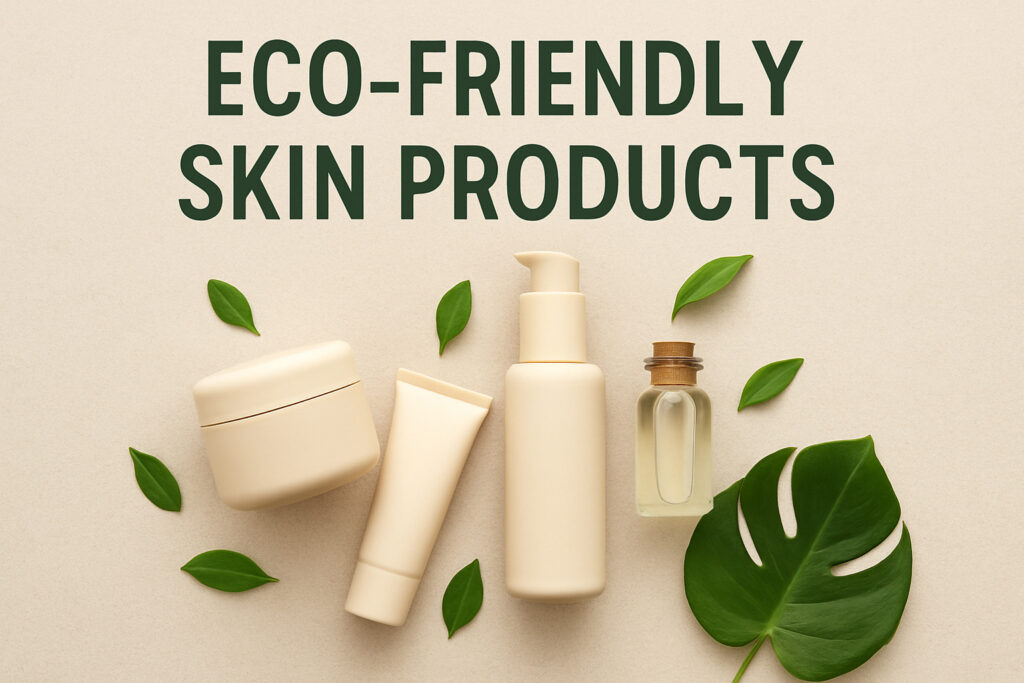Why Sustainable Skincare Matters for Your Skin and the Planet
Eco friendly skin products are skincare formulations made with naturally-derived, non-toxic ingredients, sustainable packaging, and ethical manufacturing practices that minimize environmental impact while keeping your complexion healthy.
Quick Guide to Eco-Friendly Skincare:
- Ingredients: Plant oils, botanical extracts, mineral actives
- Packaging: Recyclable glass, aluminum, refillable or compostable tubes
- Certifications: USDA Organic, Leaping Bunny, EWG Verified
- Avoid: Parabens, phthalates, synthetic fragrance, plastic microbeads
- Benefits: Gentler on sensitive skin, biodegradable formulas, smaller carbon footprint
The beauty industry is in the middle of a major clean-up. One advocate puts it best: “Clean beauty isn’t a trend; it’s a transformative force reshaping the industry.”
Traditional skincare can contain chemicals linked to health concerns and environmental damage. Sustainable alternatives rely on ingredients your skin recognizes—sea minerals, plant oils, soothing botanicals—while ditching excess plastic and high-pollution production methods.
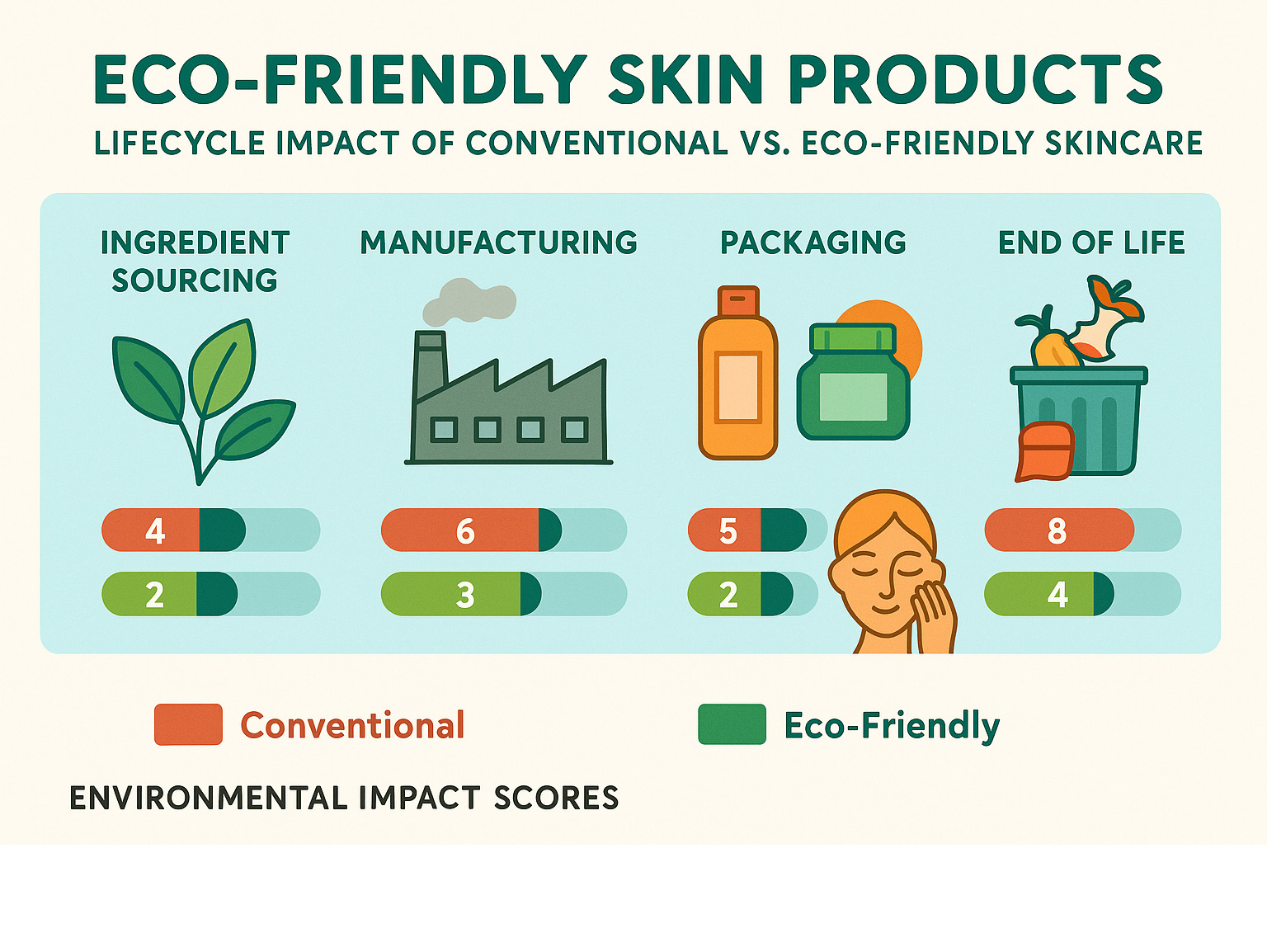
Common eco friendly skin products vocab:
Why Sustainable Skincare Matters
Our beauty routines carry a bigger environmental footprint than we realise. The average person uses 12 personal-care products daily; many contain ingredients that linger in waterways and come in packaging destined for landfills.
Microplastics from conventional beauty make their way into oceans and even our food chain. Choosing biodegradable formulas and low-waste packaging literally helps clean up the planet—while often giving sensitive skin a gentler experience.
What Makes a Skin Product Truly Eco-Friendly?
Here’s the thing about shopping for sustainable skincare – the beauty aisle can feel like a minefield of confusing claims. “Natural,” “green,” and “eco-friendly” get thrown around so much that it’s hard to know what actually makes a difference.
The real magic happens with green chemistry – basically, creating products using renewable resources and manufacturing processes that don’t trash the planet. Think of it as beauty with a conscience. Instead of harsh synthetic chemicals, these formulations rely on plant-based alternatives that work with your skin rather than against it.
Ethical sourcing is where things get really interesting. The best brands don’t just buy ingredients from whoever’s cheapest. They build relationships with farmers, ensure fair wages, and support sustainable harvesting practices. Some even go the extra mile by funding reforestation projects or protecting biodiversity in the areas where they source their botanicals.
When you’re trying to steer all the marketing noise, certifications become your best friend. Look for USDA Organic (which requires 95% organic ingredients), Leaping Bunny certification for truly cruelty-free practices, or EWG Verified for products free from sketchy chemicals. These aren’t just fancy badges – they represent rigorous third-party testing.
One of the coolest innovations we’re seeing is refill systems. Brands offering refillable containers can slash packaging waste by up to 85%. Some even have take-back programs where you can return empty containers for proper recycling or creative upcycling. It’s like having a beauty routine that gives back to the planet.
Scientific research on harmful chemicals has revealed some pretty concerning stuff about conventional skincare ingredients. We’re talking hormone disruption, allergic reactions, and chemicals that accumulate in our bodies over time. Truly eco friendly skin products sidestep these issues entirely by choosing safer alternatives from the start.
Ingredients to Seek Out
The best eco friendly skin products work because they tap into ingredients that have been perfecting themselves for millions of years. Plant oils like jojoba, rosehip, and argan are molecular twins to our skin’s natural oils, which means they absorb beautifully without leaving you looking like a glazed donut.
Seaweed and marine algae are the sustainability champions of the ingredient world. They grow crazy fast without needing fresh water, pesticides, or fertilizers. Plus, these ocean botanicals are loaded with minerals, vitamins, and antioxidants that can help firm and hydrate your skin naturally.
Niacinamide (vitamin B3) is like the Swiss Army knife of skincare ingredients. It helps balance oil production, minimizes pores, and calms inflammation – all while being gentle enough for sensitive skin. Most of it comes from plant sources, making it a win-win for you and the environment.
Aloe vera has been soothing irritated skin for centuries, and it’s incredibly sustainable to grow. The plant needs minimal water and can be harvested over and over again from the same source. It’s nature’s way of saying “I’ve got your back.”
Probiotics and prebiotics are the new kids on the block, and they’re pretty exciting. These beneficial bacteria help support your skin’s natural ecosystem, leading to clearer, more balanced skin over time. It’s like having a tiny garden party on your face – in the best possible way.
Ingredients to Avoid
Nobody likes being the bearer of bad news, but some common skincare ingredients can be problematic for both your skin and the planet. Parabens (look for methylparaben, propylparaben, and butylparaben on labels) are preservatives that have been linked to hormone disruption and stick around in the environment way longer than they should.
Phthalates are sneaky little chemicals that often hide behind the word “fragrance” on ingredient lists. They’ve been associated with reproductive health concerns and don’t break down easily in water systems. Not exactly what you want in your daily moisturizer.
Sulfates like sodium lauryl sulfate create that satisfying foamy lather that makes us feel squeaky clean. But they can actually strip away your skin’s natural protective barrier and are toxic to aquatic life. Your skin barrier works hard to protect you – why make its job harder?
Triclosan is an antimicrobial agent that sounds helpful but actually contributes to antibiotic resistance and can mess with thyroid function. It’s also harmful to marine ecosystems, which affects the whole food chain.
Scientific research on synthetic fragrances has shown that these complex chemical cocktails can trigger allergies, headaches, and breathing issues. They’re also incredibly difficult to remove from wastewater, which means they keep affecting aquatic life long after they’ve gone down your drain.
Top 10 Eco Friendly Skin Products for Every Routine
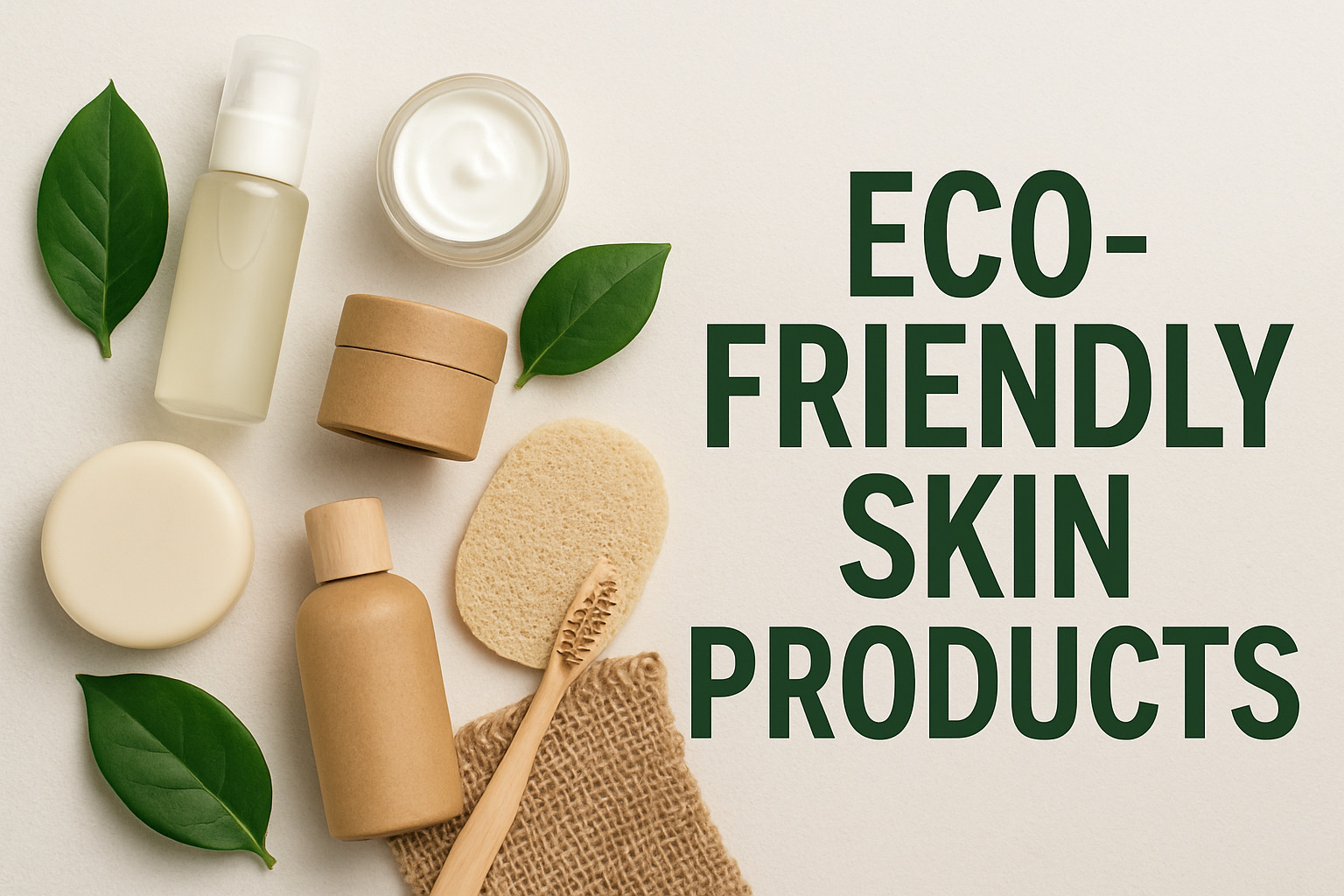
Ready to refresh your routine with eco friendly skin products that truly work? After testing dozens of options, we’ve hand-picked 10 standouts that combine impressive results with planet-positive credentials. Every item meets three strict rules: vegan formulas, responsible sourcing, and plastic-free or easily recyclable packaging.
Best Eco Friendly Skin Products for Cleansing
Oil-to-milk cleansers dissolve makeup, then rinse away as a gentle milk—no tight, squeaky feeling. Most arrive in glass or aluminum that you can recycle forever, and several brands offer refill pods to cut waste.
Solid cleansing bars are now pH-balanced and rich in coconut or shea butter. One bar lasts 2–3 months and skips plastic entirely; many bars double as body cleansers, making travel simpler.
Prefer a deeper detox? Clay cleansers using responsibly mined French green or rhassoul clay draw out impurities and are 100 % biodegradable.
Most-Loved Eco Friendly Skin Products for Moisturizing
Waterless balms deliver concentrated hydration, need no preservatives, and ship lighter—reducing emissions. They’re usually housed in refillable glass jars or compostable tubes.
Looking for anti-aging power? Bio-retinol alternatives like bakuchiol (from the Psoralea corylifolia plant) smooth fine lines without irritation or sun sensitivity.
Sea mineral moisturizers provide essential minerals from fast-growing kelp and algae—great for your skin barrier and gentle on resources.
Targeted Treatments That Stay Planet-Kind
• Vitamin C serums made with Kakadu plum or acerola cherry supply potent antioxidants while supporting sustainable farming.
• Bakuchiol serums mimic retinol results without harsh side-effects.
• Blue-light defense formulas use algae-derived astaxanthin to fend off digital stress.
Concentrated drops mean you need fewer bottles overall—another simple way to shrink your beauty footprint.
Sustainable Packaging & Waste Reduction Strategies
When it comes to eco friendly skin products, the packaging can make or break your sustainability goals. It’s frustrating to find a perfectly formulated natural serum only to find it comes wrapped in layers of unnecessary plastic!
The good news? The beauty industry is finally catching up with innovative packaging solutions that are as thoughtful as the formulas inside.
Recyclable glass is having its moment – and we’re here for it. Unlike plastic, which degrades each time it’s recycled, glass can be recycled endlessly without losing quality. Those beautiful amber glass bottles aren’t just Instagram-worthy; they’re protecting your vitamin C serum from light damage while being infinitely recyclable. Many customers tell us they love repurposing these containers for everything from spice storage to mini planters.
Aluminum tubes are another smart choice that’s gaining popularity. Aluminum is incredibly lightweight (hello, lower shipping emissions!) and can be recycled forever. Plus, it provides excellent protection for active ingredients that might degrade in other packaging materials.
Here’s where things get really exciting: refill systems are revolutionizing how we think about skincare packaging. These clever refill pods can slash packaging waste by up to 85% compared to buying new containers every time. Some brands have perfected subscription services where your refills arrive in compostable mailers – it’s like getting a sustainable surprise in your mailbox.
Compostable packaging represents the cutting edge of sustainable beauty. We’re seeing incredible innovations using mushroom mycelium, seaweed-based films, and plant-derived plastics that break down naturally in home compost bins. It feels almost magical to toss your empty skincare container into your compost pile knowing it’ll become soil within months.
For deeper insights into these packaging innovations, check out more info about Eco-Friendly Skin Care Packaging to understand which options work best for different product types.
From Bathroom to Bin: Closing the Loop
The most forward-thinking brands aren’t just thinking about what happens when you buy their products – they’re planning for what happens when you’re done with them.
Take-back schemes are becoming surprisingly common. Some brands will actually accept their empty containers back for proper recycling or creative upcycling. Even better, many offer discounts on your next purchase when you return empties. It’s like a loyalty program that rewards you for being environmentally conscious.
Those little QR codes appearing on packaging aren’t just trendy tech – they’re treasure troves of sustainability information. Scan one and you might find exactly how to dispose of that unique bio-plastic tube, or learn about the carbon footprint of your favorite moisturizer. This transparency helps you make smarter choices and dispose of products responsibly.
Life Cycle Assessments (LCAs) might sound technical, but they’re incredibly important. These comprehensive studies track a product’s environmental impact from ingredient sourcing all the way through disposal. The most responsible companies share these assessments publicly and use them to continuously improve their sustainability practices. When brands are transparent about their LCAs, it shows they’re serious about reducing their environmental footprint rather than just talking about it.
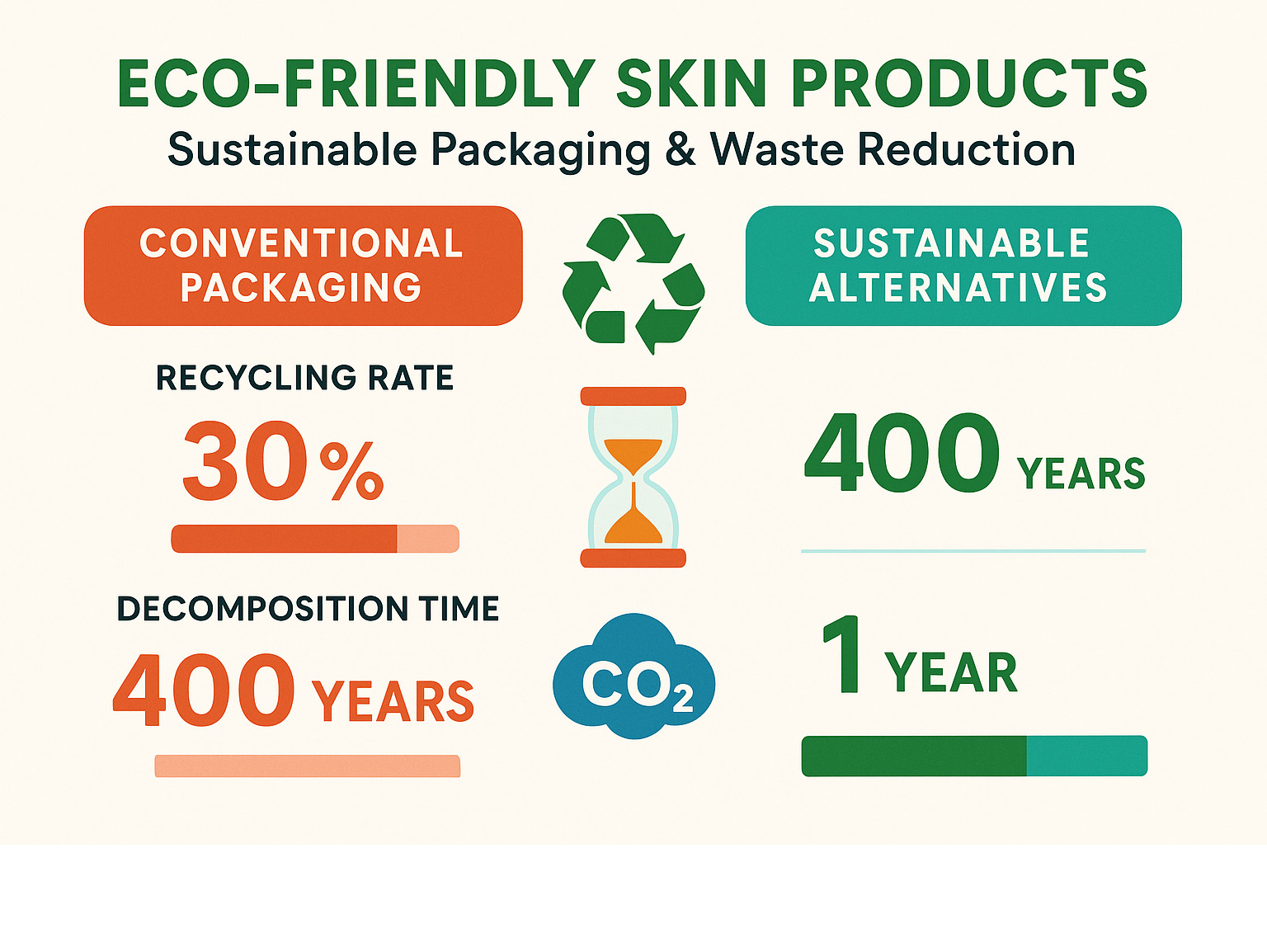
How to Transition Your Routine to Eco Friendly Skin Products
Making the switch to eco friendly skin products doesn’t have to feel overwhelming. Think of it as a gentle journey rather than a complete overhaul – your skin (and wallet) will thank you for taking it slow.
The smartest approach? Replace products as they run out instead of tossing half-full bottles. This step-by-step method gives your skin time to adjust while being kind to your budget. Start with the heavy hitters – your daily cleanser and moisturizer – since these are the products you use most often.
Your skin type should guide your choices. If you have sensitive skin, look for products with shorter ingredient lists and skip anything with strong essential oils or high concentrations of actives. Those with oily skin often find that plant-based oils like jojoba actually help balance sebum production rather than making things worse. Dry skin types will love the rich, nourishing feel of products packed with plant butters and ceramides.
Budget-friendly doesn’t mean compromising on quality. Many accessible brands now offer eco-conscious lines, and solid products like cleansing bars often give you more bang for your buck than their liquid counterparts.
Mindful shopping means becoming a bit of a detective. Read those ingredient lists, research brands’ actual sustainability practices (not just their marketing claims), and choose quality over quantity. More info about Affordable Eco-Friendly Skin Care can help you find effective products that won’t strain your budget.
| Conventional Product | Eco-Friendly Alternative | Key Benefits |
|---|---|---|
| Foaming face wash with SLS | Gentle cleansing oil or solid bar | Less stripping, plastic-free packaging |
| Moisturizer in plastic pump | Glass jar or refillable container | Infinitely recyclable, often more concentrated |
| Synthetic retinol serum | Bakuchiol or rosehip oil | Gentler, pregnancy-safe, sustainably sourced |
| Plastic exfoliating beads | Enzyme or sugar scrubs | Biodegradable, won’t harm marine life |
| Aerosol sunscreen | Mineral sunscreen in glass/aluminum | Reef-safe, better for sensitive skin |
Starter Kit for Newbies
If you’re just dipping your toes into eco-friendly skincare, these four essentials will set you up for success without overwhelming your routine or your skin.
A gentle cleanser forms the foundation of any good routine. Oil-based cleansers or pH-balanced solid bars won’t strip your skin’s natural protective barrier. Look for nourishing ingredients like coconut oil, olive oil, or plant-derived gentle surfactants that actually leave your skin feeling soft.
Your daily moisturizer should be simple but effective. Formulations with plant-derived hyaluronic acid, ceramides, or lightweight plant oils will keep your skin happy without causing breakouts or irritation. The best eco-friendly moisturizers often feel more luxurious than their conventional counterparts.
Broad-spectrum SPF is non-negotiable, and mineral sunscreens with zinc oxide or titanium dioxide are both reef-safe and gentler on sensitive skin. Many eco-friendly brands offer beautifully tinted options that work as lightweight foundation alternatives.
Don’t forget nourishing lip care – a simple balm with organic oils and butters protects this delicate area while giving you a taste of how effective natural ingredients can be. You’ll likely notice the difference in texture and longevity compared to conventional lip products.
Advanced Swaps for Skincare Enthusiasts
Once you’ve mastered the basics, you can explore more sophisticated eco friendly skin products that offer both performance and sustainability benefits.
Refillable systems are worth the initial investment. While the upfront cost might be higher, you’ll save money over time and dramatically reduce your packaging waste. Many brands offer beautiful glass containers that look gorgeous on your vanity and can be refilled indefinitely.
Multi-use products are the Swiss Army knives of sustainable skincare. A high-quality balm might work as moisturizer, makeup remover, and cuticle treatment all in one. Plant oils can often pull double or triple duty for face, body, and hair care.
DIY mask ingredients let you create spa-worthy treatments with zero packaging waste. Keep simple powerhouses like raw honey, colloidal oatmeal, and clay on hand for weekly pampering sessions.
Frequently Asked Questions about Eco-Friendly Skincare
Are eco-friendly products effective for sensitive skin?
Here’s some wonderful news for anyone with sensitive skin – eco friendly skin products are often your skin’s best friend! We’ve found that these gentler formulations typically contain fewer harsh chemicals and synthetic fragrances that can cause redness, irritation, or breakouts.
Think about it this way: plant-based ingredients like aloe vera, chamomile, and oat extract have been soothing sensitive skin for centuries. These natural powerhouses come with built-in anti-inflammatory properties that can actually calm irritated skin while delivering the results you want.
But here’s an important reality check – “natural” doesn’t automatically mean “gentle.” Some essential oils can be quite potent and might irritate sensitive skin types. The key is choosing products specifically formulated for your skin’s needs.
We always recommend doing a patch test before diving into any new routine. Apply a small amount of the product to your inner wrist or behind your ear, wait 24 hours, and see how your skin responds. Your skin will thank you for this extra step!
How can I spot greenwashing on labels?
Unfortunately, not every brand that claims to be “green” actually walks the walk. Greenwashing has become a real issue in the beauty world, but you can become a savvy detective with a few simple tricks.
Watch out for vague buzzwords like “natural” or “eco-friendly” that sound impressive but don’t really mean anything specific. These terms aren’t regulated, so anyone can slap them on a label.
Another red flag? Products that shout about one or two natural ingredients while quietly hiding a long list of synthetic chemicals in the fine print. It’s like putting a single organic strawberry on top of a processed dessert and calling it healthy!
Pay attention to packaging that looks eco-friendly but isn’t actually made from sustainable materials. Some brands use green colors and earthy fonts to create an environmental vibe without making real changes to their practices.
The best approach is to look for brands that are transparent about their entire process – from ingredient sourcing to manufacturing to packaging. Companies that are genuinely committed to sustainability love to share the details of their efforts.
Which certifications should I trust the most?
Navigating beauty certifications can feel overwhelming, but focusing on a few key ones will help you make confident choices about eco friendly skin products.
USDA Organic is the gold standard for organic beauty products. This certification requires that 95% of ingredients are organic and follows strict manufacturing standards. When you see this label, you know the product has been thoroughly vetted.
For cruelty-free products, Leaping Bunny certification is your most reliable friend. This program has the strictest standards and requires ongoing monitoring to ensure no animal testing occurs at any stage of product development.
EWG Verified products have been screened by the Environmental Working Group and are free from their chemicals of concern. This certification focuses specifically on ingredient safety and transparency.
If you’re shopping for products made in Europe, COSMOS Organic represents the European standard for organic cosmetics and is highly respected internationally.
Fair Trade Certified ingredients ensure that farmers and workers receive fair wages and work in safe conditions. This certification shows a brand cares about people as much as the planet.
Be cautious of proprietary certifications that brands create for themselves. While some companies have high standards, these self-created labels don’t have the independent oversight that makes third-party certifications so valuable.
Conclusion
The beauty world is changing before our eyes, and honestly, it’s about time. Eco friendly skin products aren’t just another passing trend – they represent a genuine shift toward caring for ourselves and our planet simultaneously.
Here’s what we’ve finded: choosing earth-first choices actually leads to that glowing skin you’ve been after. Many of our readers are amazed when they realize their new sustainable routine works better than their old conventional products. It makes sense when you think about it – these formulas are packed with high-quality botanical ingredients instead of harsh synthetic fillers.
Every time you pick up a product, you’re essentially casting a vote. When we support brands that prioritize sustainable packaging, ethical sourcing, and transparency, we’re telling the entire beauty industry what matters to us. And trust us, they’re listening.
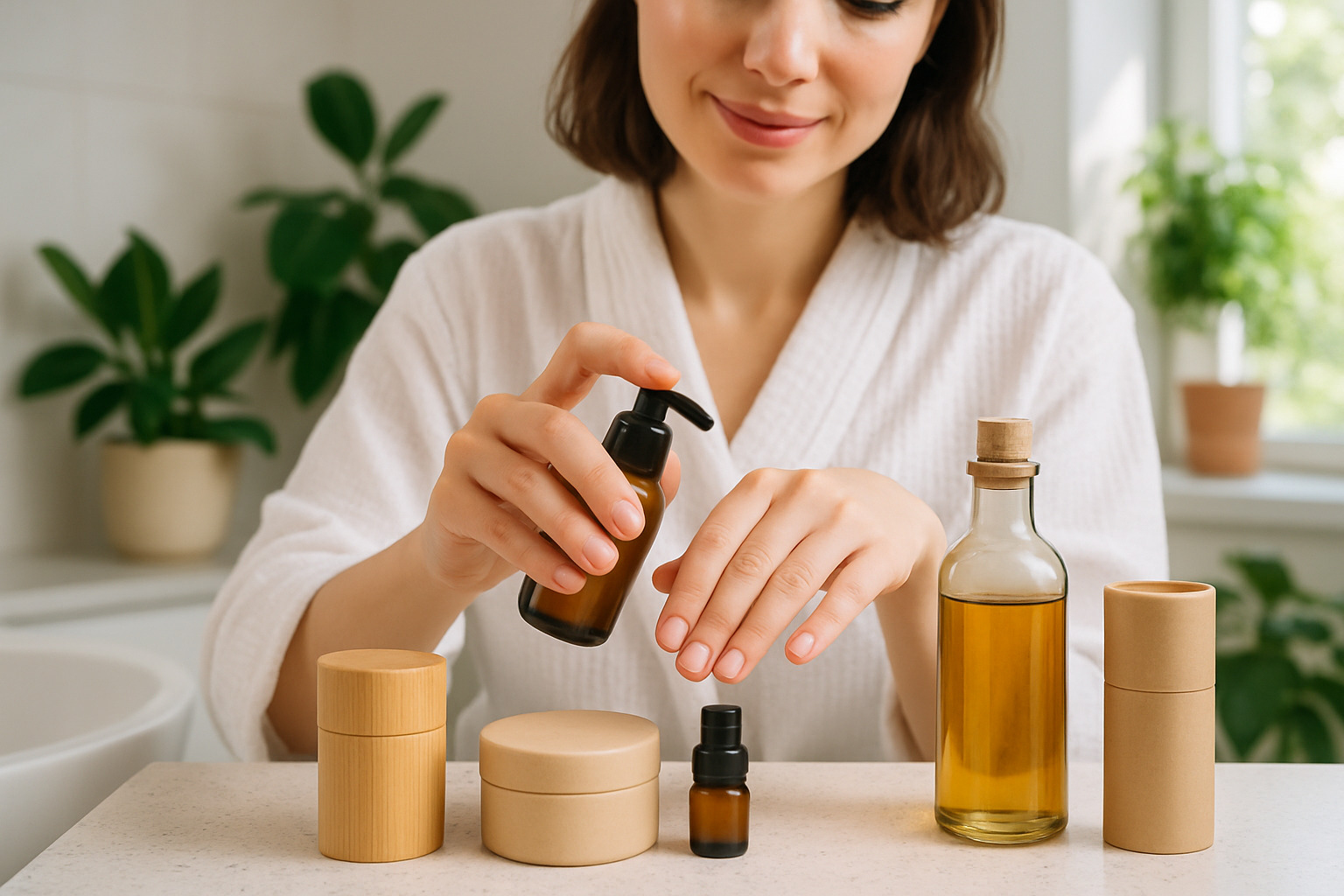
As conscious consumers, we have more power than we realize. The beauty industry is responding to demand for cleaner, greener products because people like you are asking for them. Your choices matter, whether you’re swapping out one product or overhauling your entire routine.
At Beyond Beauty Lab, we’re here to support your journey toward more sustainable beauty practices. Starting small is perfectly fine – even switching just your cleanser or moisturizer makes a difference. The key is choosing products that align with your values while delivering the results you want.
Ready to dive deeper into sustainable beauty? Our comprehensive guide to Eco-Friendly Beauty Routines offers even more practical tips and product recommendations to help you create a beauty regimen that’s truly kind to both your skin and the planet.
The future of beauty is green, and you’re already part of making it happen.

